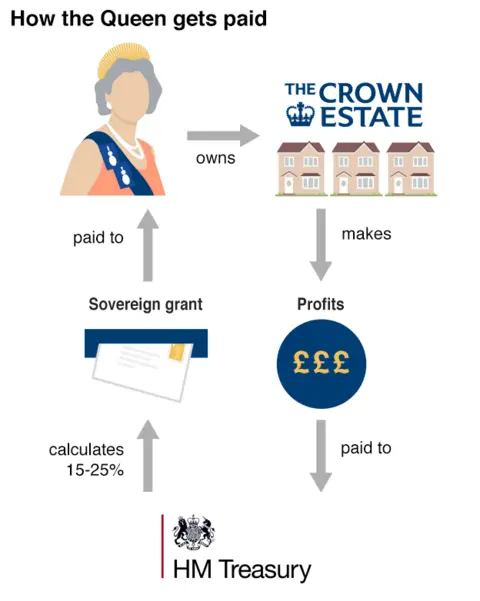Queen to receive £6m pay increase from public funds
The Queen is to receive an 8% increase in income from public funds, after the Crown Estate's profits rose by £24m.
The Sovereign Grant, which pays for the salaries of her household, official travel and upkeep of palaces, is to increase by more than £6m in 2018/19.
It comes as accounts revealed the Queen's official net expenditure last year increased by £2m, to almost £42m.
Sir Alan Reid, Keeper of the Privy Purse, said the Queen represented "excellent value for money".
He said: "When you look at these accounts, the bottom line is the Sovereign Grant last year equated to 65p per person, per annum, in the United Kingdom.
"That's the price of a first class stamp.
"Consider that against what the Queen does and represents for this country, I believe it represents excellent value for money."

You might also like...

The Queen and the Royal Family's official travel cost the taxpayer £4.5m during 2016/17, up £500,000.
Clarence House has also released its annual accounts, which showed the Prince of Wales' annual income from his hereditary estate, the Duchy of Cornwall, increased by 1.2% - to £20.7m.

Royal accounts - some key figures
- £82.2m - Amount the Queen is expected to get from the Sovereign Grant in 2018/19
- £4.5m - Cost of the Queen and the Royal Family's official travel in 2016/17
- £288,697 - Amount spent on the Royal Train travel for 14 trips
- £1.2m - Cost of replacing doors on the orangery at Windsor Castle
- £154,000 - Estimated cost of Prince Charles and Camilla using "Cam Force One" - the official government plane - to visit Italy, Romania and Austria earlier this year

The Sovereign Grant, which is paid two years in arrears, is money given to the Queen by the Treasury.
It is based on the profits of the Crown Estate portfolio, which includes much of London's West End.
The Crown Estate posted a £24.7m rise in profits, to £328.8m, in 2016/17.

Analysis
 PA
PABy Peter Hunt, royal correspondent, BBC News
For decades, royals and their use of taxpayers' money have had the potential to be a toxic combination.
This latest increase in funding - the Sovereign Grant will have risen from £31m to £82m over six years - has been made public at a time of continued pay restraint in the public sector and when there is a focus, after the Grenfell Tower fire, on the divide between rich and poor.
Add in the £17,000 it cost to fly Prince Charles on a private plane between two of his residences and the ancient institution's critics cry foul. As they do each year.
And each year aides stress that a regal eagle eye is kept on travel costs and the extra cash is needed to save Buckingham Palace from damaging disrepair.
The generous royal funding formula will be reviewed in four years time. It's meant to last until 2026.
Royal officials have said they've no reason to believe "it won't remain in place".

Republic, which campaigns for an elected head of state, published its own report on royal expenses.
It said that once security and other costs were included, the annual bill for the monarchy was nearer £345m.
Graham Smith, the organisation's chief executive, said it was a "massive bill for the taxpayer" to support "privileged lifestyles".
The increase in funding will take place as extensive repairs are being carried out at Buckingham Palace, costing £369m.
To help pay for the work at the palace, the percentage of the Crown Estate profits paid to the Queen will increase from 15% to 25% between 2017 and 2027.


What is the Crown Estate?
- It is an independent commercial property business and one of the largest property portfolios in the UK
- Most of the portfolio is made up of residential property, commercial offices, shops, businesses, and retail parks
- The estate started in 1760 when it was agreed that surplus revenue from the crown's estate would go to the Treasury and, in return, the monarch would receive an annual payment
- The estate belongs to the monarch for the duration of their reign, but cannot be sold by them and profits go to the Treasury
- The monarch is then given 15% of the annual surplus of the estate, known as the Sovereign Grant, to support official duties - from funds two years in arrears
- This percentage will increase from 15% to 25% between 2017 to 2027 to help pay for a £369m refurbishment of Buckingham Palace
